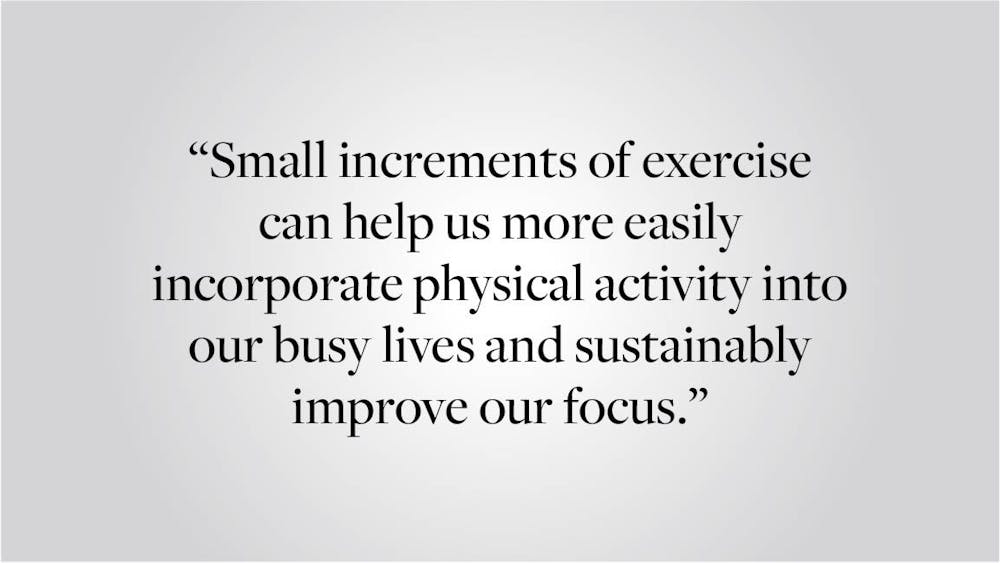Though I’m technically taking fewer classes at Brown than I did in high school, I’m learning that the classwork rarely ceases. The constant stream of papers, problem sets and preparation for tests mean lots of long hours in my dorm and at the library sitting at my computer. What’s keeping me sane from the monotony of studying are “exercise snacks,” or short movement bursts such as walking, jumping jacks and stair-climbing that stimulate the body and mind. Small increments of exercise can help us more easily incorporate physical activity into our busy lives and sustainably improve our focus.
Exercise snacks also help the brain. Working out between study intervals increases heart rate, pumping more oxygen to the brain and boosting cognitive function. It can also promote neuroplasticity and cause the brain to secrete endorphins, boosting mood and improving focus — just what is needed to fight against a midday slump. Engaging in movement, such as a quick walk, can also relieve tension and stress that may arise from a difficult assignment or preparation for a test.
An added advantage of exercise snacking is that it is an easily accessible method of physical activity for individuals who may not have the time or financial resources to participate in more structured forms of working out. Because they’re short, simple and require no advanced equipment, exercise snacks are often easier for individuals to consistently commit to and serve as an introduction to working out for those seeking to begin their fitness journeys. Exercise snacks can take any form an individual chooses. For me, exercise snacking includes taking the stairs instead of the elevator, going for a run in the late afternoon when I’m most unproductive and taking a walk around College Hill while calling my parents. These activities help me check in with my thoughts and allow me to get outside and breathe fresh air instead of sitting inside all day. Similarly, a friend of mine likes to sing or dance to her favorite music when she’s cramming for an exam to relieve stress.
It's time we expand our idea of physical activity beyond typical hour-long workout sessions in gyms, which is a version of exercise that isn’t accessible or achievable for large swaths of people. For example, working students, parents and those with chronic pain or illness may experience difficulty negotiating the transportation, space, cost and physical demands of a typical workout into their daily schedule. Exercise snacks allow individuals to be creative with how they work out, whether it be walking to a favorite podcast or engaging in an impromptu dance party. According to Martin Gibala, a professor of kinesiology at McMaster University who has conducted several studies on exercise snacking, brief bursts of exercise allow us to stay active anywhere under almost any circumstances. In a New York Times interview, Gibala said, “You can just be active, even if it means setting your watch to trigger you to do some squats or wall sits for one minute after an hour of sitting.”
Among the litany of fitness crazes, it may seem hard to imagine that small and uncomplicated exercise snacks offer benefits. However, these short spurts of activity can increase endorphins, among providing other cognitive benefits that can help promote focus. Today, you might not have 30 minutes to exercise, but you probably have three 10-minute breaks. Why not dedicate that time to something that can make your brain happier?
Juliet Fang ’26 can be reached at juliet_fang@brown.edu. Please send responses to this opinion to letters@browndailyherald.com and other op-eds to opinions@browndailyherald.com.
Juliet Fang is a second year at Brown studying Ecology and Evolutionary Biology. In her free time, she enjoys running, cycling, and watching duck videos.





